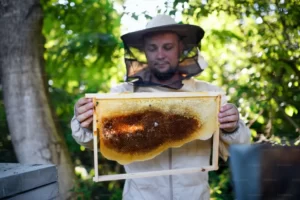Table of Contents
Manuka Honey for Dandruff: Natural Treatment Options for Beard Dandruff and Seborrheic Dermatitis
Introduction
We’ve all heard about scalp dandruff. And while it’s a common skin condition, your scalp isn’t the only part of your body where you may notice white flakes and itching. Men with facial hair may also experience beard dandruff. If the skin under your facial hair feels itchy and has begun flaking, you could be looking at a case of beard dandruff. It’s more common than you think, just not often discussed. Shaving your beard would be one of the best ways to eliminate the problem. But, of course, your beard may be a prominent feature of your look and a great confidence boost; hence, a clean shave might not be the most favorable option. The good news is that there are other natural methods to treat beard dandruff that don’t require you to get rid of your facial hair! In this article, we’ll explore the causes of beard dandruff, the underlying skin condition known as seborrheic dermatitis, and natural treatment options for both.
What Causes Beard Dandruff?
Seborrheic dermatitis is a non-contagious skin condition that primarily affects areas of your skin rich in sebaceous glands. These glands secrete sebum, an oily substance. Sebaceous gland-rich regions include your face, scalp, and chest. These areas are where you’d typically observe symptoms of seborrheic dermatitis. Some symptoms you may notice include itch, inflammation, flaky skin, and skin irritation. Another cause of beard dandruff may just be dry skin. If you only notice flaky skin without the additional redness, itchiness, or irritation, then dry skin is likely the culprit. Additionally, natural beard oil and the accumulation of dead skin cells may also be another cause, especially if your facial hair isn’t cleaned and groomed often enough. If your skin cells regenerate quicker than normal, this could lead to a greater accumulation of dead skin cells and the formation of dandruff flakes.
What Causes Seborrheic Dermatitis, Then?
So now that we’ve established seborrheic dermatitis as the most common cause of beard dandruff, the focus now redirects to the causes of seborrheic dermatitis. Well, scientists are still unsure what the exact cause of seborrheic dermatitis is. But a possible culprit has been highlighted. It’s. This fungus typically resides on your skin, staying out of any trouble. However, some research suggests that the rapid growth of Malassezia on the skin can lead to the development of seborrheic dermatitis. As Malassezia consumes the sebum on your skin, it breaks it down into fatty acids such as oleic acid, which can irritate the skin and cause an inflammatory response in some people. Hence, the Malassezia fungus may be responsible for the white flakes, itching, and red skin under your beard or facial hair. While the Malassezia fungus is thought to be a prominent cause of seborrheic dermatitis, some other factors may also aggravate your condition or trigger a flare-up.
How To Prevent Beard Dandruff
There are various methods of preventing and treating beard dandruff. Let’s explore them!
-
Over-the-counter antifungal shampoos: There are various over-the-counter antifungal shampoos that you can purchase. The main ingredient to look out for is ketoconazole. Research has proven ketoconazole shampoo to be effective in tackling seborrheic dermatitis and dandruff. You may start with a lower concentration (i.e.,1% ketoconazole shampoo). Higher concentrations and stronger doses typically require a prescription from your doctor. Since ketoconazole has antifungal properties, it can kill off the fungus present around your facial hair region, alleviating symptoms of beard dandruff. Some shampoos may contain other antifungal agents, such as pyrithione zinc and selenium sulfide. Start using the medicated shampoo a few minutes before you take your shower. Massage the shampoo into your beard, giving it enough time to seep in and reach the skin beneath your beard hair. You can then thoroughly wash it off when you take your shower.
-
Proper beard maintenance: Fortunately, the general regimen for keeping your chin fuzz well-maintained is relatively simple. Here are some practical ways to maintain a healthy beard and keep skin problems at bay:
- Wash your beard regularly: Use a mild shampoo or beard wash to clean your beard and remove any trapped moisture, dirt, or dead skin cells.
- Condition your beard: After washing, apply a beard conditioner or beard oil to keep your facial hair moisturized and prevent dryness.
- Brush your beard: Use a beard brush or comb to gently brush your beard, which helps distribute oils and get rid of any tangles.
- Avoid harsh chemicals: Avoid using harsh chemical products or ingredients that may irritate your skin and worsen beard dandruff.
- Keep your beard trimmed: Regularly trim your beard to prevent excessive growth and minimize the potential for dryness and irritation.
Natural Treatment Options for Beard Dandruff and Seborrheic Dermatitis
Some lifestyle factors may also affect the risk of a seborrheic dermatitis flare-up. For starters, a lack of sleep can aggravate your symptoms. The following are a few simple ways to achieve better quality sleep at night:
- Cultivate a restful environment for sleep. Remove distractions and keep your room dark and at a comfortable temperature.
- Create a regular sleep schedule and stick to it as closely as possible.
- Limit daytime napping.
- Watch what you eat (and drink) too near your bedtime. Being too full or hungry when heading to bed can hamper your sleep quality. And be cautious of sipping on coffee or wine too close to bedtime.
- Keep active. Physical exercise is a core pillar to better physical, emotional, and mental wellness. Add nature to the mix for an extra boost.
- Prioritize self-care. Take a hot bath, visit the farmer’s market, make kombucha tea, journal, read a book, or enjoy a massage.
- Try out relaxation techniques, deep breathing, yoga, or meditation.
- Make room and time for your hobbies.
Natural remedies have long been viewed as favorable treatments for skin problems. The fact is that these remedies may not work for everyone and may take some time to display significant benefits. That said, they’ve become popular for a couple of reasons. Some people may have experienced side effects from conventional dandruff treatment, while others are keen on combining the two to amplify their benefits. Here are some natural treatment options that may work for beard dandruff:
-
Tea Tree Oil: Tea tree oil has been shown to be effective for facial seborrheic dermatitis. According to research, it helps to minimize scaling, itching, redness, and the formation of greasy crusts associated with seborrheic dermatitis. Before using tea tree oil for beard dandruff, ensure you dilute it in water or carrier oil. Alternatively, you may look for a shampoo or facial product containing tea tree oil.
-
MCT Oil: While there haven’t been many research studies on the efficacy of MCT oil for dandruff or seborrheic dermatitis, anecdotal reports on its benefits are promising. MCT is one of the safest oils that are less likely to fuel the growth of the Malassezia fungus. You may massage a small amount of MCT oil directly into your beard. Alternatively, you can mix it with your beard shampoo.
-
Honey: Another at-home remedy involves harnessing the natural anti-inflammatory and antifungal properties of honey. Research has revealed that honey may combat itching and scaling of the skin resulting from dandruff and seborrheic dermatitis. Researchers also noted that honey has preventative benefits that lower the risk of recurring flare-ups. It’s best to opt for medical-grade honey, which you can dilute with a bit of water for application. In the study, participants left honey on the affected areas for about three hours each day. You can do the same or leave it on overnight. But you risk attracting unwanted visitors at night (like ants) if you choose the latter.
-
Apple Cider Vinegar: Some research suggests that apple cider vinegar has antifungal effects and can help combat the growth of the Malassezia fungus. Though more studies are required to prove the efficacy of apple cider vinegar in treating dandruff, anecdotal evidence looks promising. Keep in mind that you should use undiluted apple cider vinegar directly on your skin. A typical ratio used is one part vinegar to four parts water. Apply the mixture to the affected areas, and leave it on for a few minutes before rinsing it off.
-
Aloe Vera: Aloe vera is a popular ingredient found in various facial products, and there’s a good reason why; aloe vera possesses impressive anti-inflammatory and moisturizing properties. One study found that aloe vera extract helped tackle itchy skin, scaling, and flaking resulting from seborrheic dermatitis. You can easily purchase aloe vera in various creams, gels, and products online.
Calming Seborrheic Serum
The Calming Seborrheic Serum consists of a blend of holistic ingredients that work together to calm irritated skin. The serum reduces redness, itch, and flaking by clearing the Malassezia fungus while keeping your skin well-nourished and hydrated. The Calming Seborrheic Serum is safe to use on the face, scalp, and body. No harsh or hard-to-pronounce chemicals are included in the mix, as the serum relies on humble yet powerful ingredients that help relieve moody skin. If you’re nervous about trying out a new product, we’ve got you covered with a risk-free guarantee. We’ll refund your purchase if the results don’t amaze you after 60 days. Relief awaits you; get your bottle!
Conclusion
Very hot or cold weather, feeling stressed, being deprived of sleep, certain cosmetic products, exposure to the sun, excess sweat – these are some of the factors that can aggravate seborrheic dermatitis and lead to worsening beard dandruff. It’s important to address these factors while also exploring natural treatment options for beard dandruff and seborrheic dermatitis. Whether it’s using antifungal shampoos, practicing proper beard maintenance, or trying out natural remedies like tea tree oil, MCT oil, honey, apple cider vinegar, or aloe vera, there are various ways to alleviate symptoms and promote healthier skin. Remember that what works for one person may not work for another, so it may take some trial and error to find the best solution for you. With patience and consistency, you can manage and reduce beard dandruff, allowing you to proudly showcase your facial hair without any discomfort or embarrassment.



